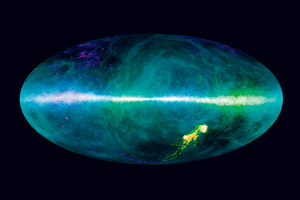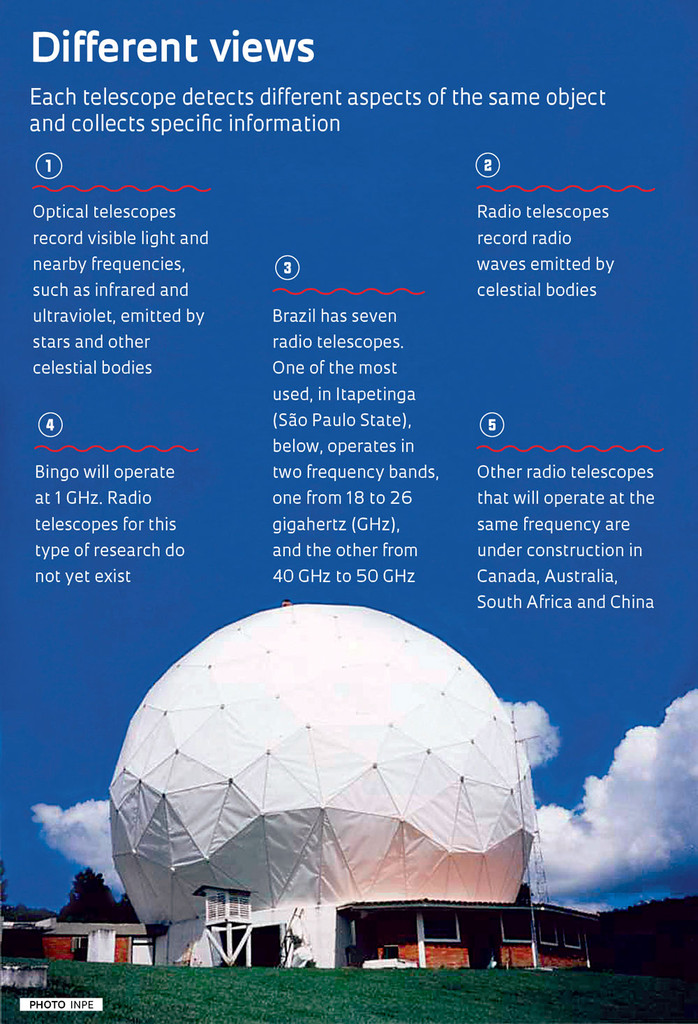
Benjamin Winkel/HI4PI Collaboration
Map of the sky, produced by radio telescopes, reflects the radiation from hydrogen at 1 GHz. The horizontal strip in the center represents the Milky Way. The region below it, to the right, shows two nearby galaxies, the Magellanic Clouds.Benjamin Winkel/HI4PI CollaborationAfter three years of planning and the release of funding from foundations in the United Kingdom and Brazil, construction is set to begin in 2017 on a radio telescope in northern Uruguay. It will be used to identify a specific frequency of the electromagnetic radiation emitted by hydrogen billions of years ago. With this new equipment, Brazilian, English, Swiss, Uruguayan and Chinese physicists hope to obtain more information on the distribution of galaxies and phenomena that took place when matter separated from electromagnetic radiation. This occurred 370,000 years after the Big Bang, the explosion believed to have given rise to the Universe, which transpired about 13.7 billion years ago.
The atomic particles formed a plasma, at a temperature of about 3,000 degrees Celsius at the time the matter and radiation separated, according to specialists. “In the primordial plasma there were waves of matter arising from the interaction between matter and electromagnetic radiation. After the separation of matter and radiation, the waves that propagated in space froze, generating correlations in the distribution of matter,” explains physicist Élcio Abdalla, professor at the Institute of Physics of the University of São Paulo (IF-USP) and project coordinator, together with physicist Carlos Alexandre Wuensche, researcher at the National Institute for Space Research (INPE).
The radio telescope is called Bingo, short for Baryon Acoustic Oscillations in Neutral Gas Observations — with the neutral gas being hydrogen and the oscillations generated by the interaction between atoms (baryonic matter) and radiation. The objective is to measure the typical radiation of hydrogen, the most common element in the Universe, in an electromagnetic emission line with a wavelength of 21 centimeters, which is equivalent to a frequency of 1.421 gigahertz (GHz). This radiation reaches Earth at frequencies from 0.9 to 1.2 GHz due to the distance traveled.
 Collaboration
Collaboration
Brazilians contributed to building the equipment and assembling the telescope through FAPESP, which provided R$12 million in funding, while the British contributed about $850,000, the Swiss agreed to manufacture and send equipment worth $800,000, and the Chinese committed to a minimum of $300,000 in funding, according to Abdalla. “There are several reasons for Brazil to participate and lead a project like Bingo,” he says. According to the physicist, construction of the radio telescope will allow “a significant transfer of technical knowledge to Brazil,” through interaction with teams from other countries to build new types of equipment. As an example, he mentioned the group at the University of Manchester, which has been a leader in radar manufacturing since World War II. Similarly, collaboration with the Swiss could enhance the Brazilian teams’ knowledge of instrumentation and microwave observations. “This is the first major international collaboration led by the São Paulo team and will certainly have very positive consequences for our field in Brazil, especially for testing theories that were developed in Brazil,” emphasizes Abdalla.
“From a scientific point of view, this is a first-rate project that will investigate one of the deepest mysteries of nature: the fact that 95% of the Universe is dark and unknown,” says Abdalla. One of the members of the steering committee of the radio telescope in Uruguay, Steve Torchinsky, physicist at the Paris Observatory, told Pesquisa FAPESP: “We say that the Universe is expanding rapidly, but we don’t know why. We call this mystery dark energy, but we don’t understand its nature or how it works. Bingo might be able to help unravel the mystery of dark energy, contributing immensely to our understanding of the Universe, at a relatively accessible cost.”
The information obtained with the radio telescope should also allow the USP group to test the hypothesis that dark energy—a hypothetical form of energy that represents about 68% of the energy in the Universe today and is believed to be responsible for its continuing expansion—could interact with dark matter, supposedly responsible for about 27% of the mass of the Universe. The concept of dark matter, given this name because it cannot be directly observed, would explain the formation and distribution of mass in the Universe.
If the new radio telescope operates as expected, “we will be able to understand the history of the expansion of the Universe with a good deal of precision,” said Mark Birkinshaw, physicist at the University of Bristol, in the UK, who participated in the project. He pointed out one of the difficulties to be overcome: the Bingo radio signal is very weak and, because of this, “we have to collect a large amount of data.” According to Birkinshaw, another challenge will be to remove or avoid external interference, since the frequency band in which the radio telescope will operate is similar to that of devices such as cell phones, televisions, airplanes and satellites. This is precisely why the radio telescope will be built in a remote location in northern Uruguay.
“The construction of Bingo will be extremely important for the Uruguayan scientific community,” comments physicist Gonzalo Tancredi of the University of the Republic, in Montevideo. “We have a strong group in astronomy studying planetary sciences and another in theoretical physics studying quantum gravitation, but there is no research in observational cosmology,” he says. “Bingo will allow us to work with international leaders in this area. It will also be an opportunity to learn about the state of the art in detection and analysis techniques for radio waves.” According to him, the Telecommunications Department of the Ministry of Industry is very interested in the project.
According to the design, Bingo will have two mirrors: one measuring 48 meters (m) in diameter, with an angle of 45º, and the other measuring 40 m, positioned vertically. The former is the size of a 16-story building, and the latter a 13-story building. The mirrors will be supported by a metal structure with a weight estimated at 80 metric tons by Clive Dickinson, physicist at the University of Manchester, and a cost of nearly $1 million. Supported by a similar structure, about 10 m from the base, will be 50 boxes containing what are called the “feed horns,” cones with a height of 4.7 m and a diameter of 1.7 m. Consisting of a series of aluminum rings with different diameters and an estimated weight of 380 kg each, the feed horns are designed to capture the signals from the second mirror.
 Global race
Global race
Unlike other radio telescopes, whose antennas move to sweep the sky, Bingo will be fixed and observe a 15º region of the sky, looking for 1 GHz radiation from the neutral hydrogen clouds in galaxy clusters. “The Bingo team is trying to do something difficult, at the same time as other groups, but with different equipment,” noted Birkinshaw. “An interesting race is taking place.”
Bingo will be the smallest of similar telescopes under construction in other countries to analyze baryonic oscillations and study dark energy, but it will cost less. According to Abdalla, Bingo will be less efficient than the Square Kilometer array (SKA), whose mirrors are to be built in South Africa, and whose antennas are to be made in Australia. The size of the Uruguayan radio telescope will be similar to that of the Canadian Hydrogen Intensity Mapping Experiment (CHIME), being built in Canada, and the Tianlai project, in China.
In the town of Cachoeira Paulista, São Paulo State, an INPE radio telescope called Galactic Emission Mapping (GEM), operating since the early 2000s, with a 5.5 m antenna, covers 47% of the sky and records the radiation of the Milky Way in the 0.4 GHz to 5 GHz band. According to Thyrso Villela, INPE physicist and member of the Brazilian team, one of the most recent celestial maps generated by this radio telescope, showing the variation in intensity of radiation at 1.465 GHz in our galaxy, should help the Bingo team better understand the information collected, simultaneously, from millions of galaxies.
Project
The BINGO telescope: A new 21 cm window for exploring the dark universe and other astrophysics questions (nº 14/07885-0); Grant Mechanism Thematic Project; Principal Investigator Elcio Abdalla (USP); Investment R$12,232,307.59.